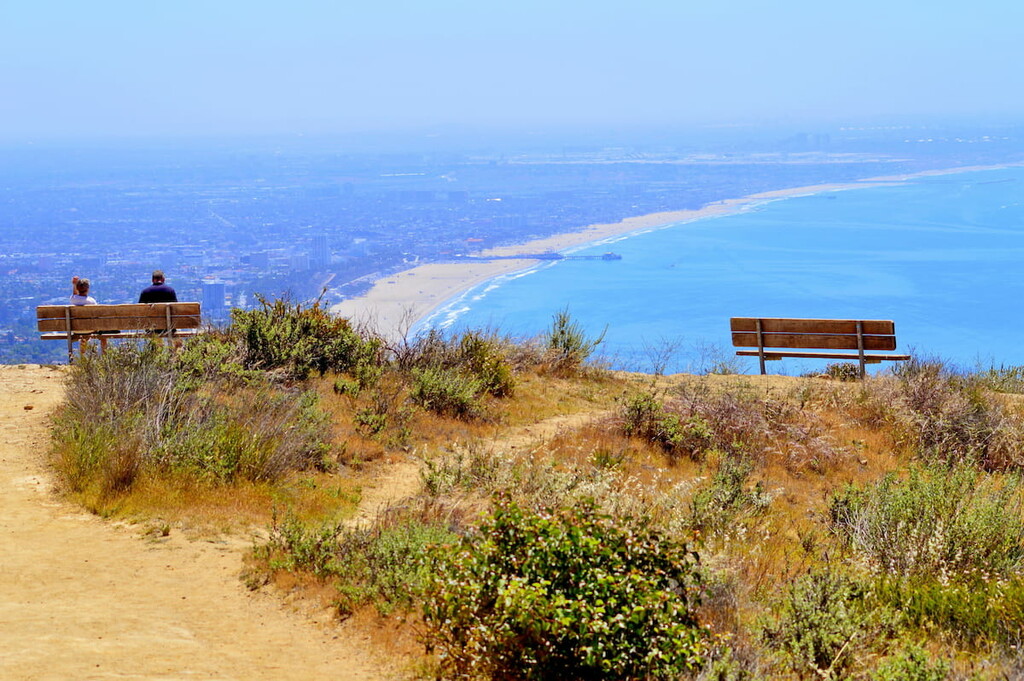BAGSMART Toiletry Bag Travel Bag with Hanging Hook, Water-resistant Makeup Cosmetic Bag Travel Organizer for Accessories, Shampoo, Full-size Container, Toiletries (Black, Medium)
$13.59 (as of March 15, 2025 23:30 GMT +00:00 - More info)Imagine yourself surrounded by stunning natural beauty, where the whisper of the wind becomes the soundtrack of your journey. At Topanga State Park, located in the heart of Los Angeles, you will discover a sanctuary that offers breathtaking scenic views, captivating hiking trails, and an escape from the hustle and bustle of the city. Whether you are a nature enthusiast seeking solace or an adventurer in search of new experiences, Topanga State Park is a must-visit destination that will awaken your senses and leave an indelible mark on your soul.
Topanga State Park
Overview
Topanga State Park is a breathtaking outdoor destination located in the beautiful state of California. With its diverse range of natural landscapes, extensive hiking trails, and abundant wildlife, the park offers visitors a chance to connect with nature and enjoy a wide array of outdoor activities. This article will provide you with a comprehensive overview of the park, including its location, history, natural environment, hiking trails, wildlife, camping options, picnic areas, visitor center, and various events and activities.
Location
Topanga State Park is situated in the Santa Monica Mountains, just a short distance northwest of the bustling city of Los Angeles. Nestled between the San Fernando Valley and the Pacific Ocean, the park’s geographical location makes it a convenient and easily accessible destination for both locals and tourists alike. Whether you’re seeking a serene escape from the urban hustle or planning a nature-filled day trip, Topanga State Park can provide the perfect outdoor retreat.
History
The rich history of Topanga State Park dates back thousands of years, with a deep connection to the Native American communities that once thrived in the region. These tribes, including the Chumash and Tongva people, considered the area sacred and relied on its natural resources for sustenance and spiritual practices. In more recent history, the land was used for ranching and agricultural purposes before being acquired by the state of California in the mid-20th century.
Natural Environment
Topanga State Park boasts a diverse natural environment characterized by varied topography, lush foliage, and unique wildlife. From rolling hills and steep canyons to vibrant wildflower meadows, the park offers a visual feast for nature enthusiasts. The flora and fauna found within its boundaries are equally impressive, with a wide range of plant and animal species calling the park home. Visitors can expect to encounter majestic oak trees, colorful wildflowers, and perhaps catch a glimpse of the park’s resident wildlife.
Hiking Trails
With over 36 miles of trails winding through its vast expanse, Topanga State Park is a hiker’s paradise. There are trail options suitable for all levels of experience, from casual strolls to challenging treks. Each trail offers its own unique points of interest, ranging from breathtaking vistas to secluded waterfalls. Whether you’re seeking a leisurely hike or a more strenuous adventure, you’ll find a trail that suits your preferences in Topanga State Park.
Wildlife
Topanga State Park is home to a remarkable array of wildlife, both common and rare. Visitors may encounter various species of birds, such as hawks, owls, and woodpeckers, as well as mammals like deer, foxes, and coyotes. The park’s diverse habitats provide a haven for many rare and endangered species, including the California red-legged frog and the Western pond turtle. Bird watchers will be delighted by the park’s avian residents, making it a prime destination for ornithology enthusiasts.
Camping
For those wishing to extend their stay and immerse themselves in the park’s natural beauty, Topanga State Park offers camping facilities. The campground provides amenities such as restrooms, picnic tables, and fire pits, allowing visitors to enjoy a comfortable outdoor experience. Campfire regulations are in place to ensure the safety of both visitors and the surrounding environment. Additionally, the park offers primitive camping areas for a more rugged and secluded camping experience.
Picnic Areas
Topanga State Park features designated areas for picnicking, making it an ideal spot for a day trip or a relaxed outdoor meal. These areas are equipped with picnic tables, grills, and trash receptacles, providing everything you need for a delightful picnic experience. It is worth noting that some picnic spots may require reservations, especially during peak seasons or for larger groups. Reserving your spot in advance will ensure you have a perfect picnic area awaiting your arrival.
Visitor Center
To enhance visitors’ experiences and provide them with valuable information, Topanga State Park has a visitor center. The center serves as an educational hub, offering exhibits on the park’s ecosystems, wildlife, and cultural history. Knowledgeable park staff are on hand to answer questions, provide trail maps, and offer guidance on recommended activities. Whether you seek to learn more about the park’s natural wonders or plan your hiking itinerary, the visitor center is an essential resource.
Events and Activities
Topanga State Park hosts a wide range of events and activities throughout the year, catering to visitors of all ages and interests. Guided nature walks provide a great opportunity to learn more about the park’s flora and fauna from knowledgeable park rangers. Photography classes enable enthusiasts to capture the park’s stunning landscapes and wildlife through their lenses. Nature workshops offer hands-on experiences, from bird watching to geology exploration. Additionally, the park plays host to special events and festivals, showcasing local artists, musicians, and cultural celebrations.
Overview
Size and Status
Topanga State Park spans over 11,000 acres, making it one of the largest state parks within the Santa Monica Mountains. Its significant size allows for a wide range of recreational activities and diverse natural landscapes for visitors to enjoy. As a state park, it is protected and managed by the California Department of Parks and Recreation, ensuring its preservation for future generations to appreciate.
Importance
Topanga State Park holds immense ecological importance as one of the few remaining protected open spaces in the Los Angeles area. Its diverse habitats support numerous plant and animal species, including those that are rare and endangered. The park also plays a crucial role in providing outdoor recreational opportunities for urban dwellers, offering a serene escape from the bustling city life.
Accessibility
One of the key advantages of Topanga State Park is its accessibility. Its close proximity to Los Angeles allows visitors to easily reach the park within a short drive. Whether you’re a local resident or a visitor to the area, Topanga State Park offers a convenient and accessible recreational option. The park’s entrance fee is reasonable, and annual passes are available for those who frequent the park regularly.
Popular Activities
The popularity of Topanga State Park stems from the wide range of outdoor activities it offers. Hiking is undoubtedly one of the most popular activities, as visitors can explore the extensive trail network and immerse themselves in the park’s natural beauty. Wildlife sightings, bird watching, and nature photography are also popular among nature enthusiasts. For those seeking a more leisurely experience, picnicking in the scenic areas or attending guided nature walks are enjoyable options. With so much to offer, Topanga State Park truly has something for everyone.
Location
Geographical Location
Topanga State Park is located in the Santa Monica Mountains in southern California. Its coordinates are 34.0912° N latitude and 118.5981° W longitude. The park covers a vast area and spans across the Santa Monica Mountains Recreation Area, providing stunning views of the surrounding landscape.
Proximity to Los Angeles
Topanga State Park is conveniently located a short distance northwest of Los Angeles. It offers urban dwellers a nature-filled escape within a 30-minute to one-hour drive, depending on traffic conditions. Its proximity to the city makes it an ideal destination for day trips, weekend getaways, or even just a quick retreat after a long day.
Directions
To reach Topanga State Park from Los Angeles, follow these directions:
- Take the US-101 N freeway.
- Take the exit for CA-27/Topanga Canyon Boulevard.
- Drive north on Topanga Canyon Boulevard for approximately 6 miles.
- Look for signs indicating the park’s entrance, and turn left to enter the park.
Parking
Topanga State Park provides parking facilities for visitors, ensuring a hassle-free experience. There are designated parking lots available at various trailheads within the park. However, during peak periods or weekends, parking may be limited. It is advised to arrive early to secure a parking spot and avoid any inconvenience.
History
Native American Connections
The history of Topanga State Park can be traced back thousands of years to its native inhabitants. Native American tribes, including the Chumash and Tongva people, inhabited the area and regarded it as a sacred land. These tribes thrived on the park’s natural resources, using them for sustenance, medicine, and spiritual practices. The park’s cultural significance and archaeological remnants bear witness to this rich indigenous heritage.
Settlement and Ranching
In the 19th century, European settlers arrived in the region, establishing ranches and agricultural enterprises. The lush meadows and fertile valleys of Topanga State Park provided an ideal location for farming and cattle grazing. Ranching continued in the area well into the 20th century, shaping the landscape and leaving behind remnants of the area’s agricultural past.
Acquisition as a State Park
Recognizing the importance of preserving the region’s natural beauty, Topanga State Park was acquired by the state of California in the 1950s. The park’s acquisition aimed to protect its diverse ecosystems, cultural heritage, and recreational opportunities. Since then, efforts have been made to conserve and restore the park’s natural resources, ensuring its accessibility and enjoyment for future generations.
Natural Environment
Topography
Topanga State Park boasts a varied topography, adding to its scenic beauty and recreational appeal. The park features rolling hills, deep canyons, and steep ridges, providing visitors with stunning vistas and dramatic landscapes. Valleys, meadows, and riparian areas are interspersed throughout, providing a diverse range of habitats for plant and animal life.
Flora and Fauna
The park’s natural environment showcases a rich array of plant and animal species. Oak woodlands dominate the landscape, with other tree species such as sycamores, willows, and alders thriving near waterways. Wildflowers add bursts of color to the park during the spring and early summer months, creating a visual spectacle for visitors. In terms of fauna, the park is home to numerous bird species, mammals, reptiles, and amphibians, making it a haven for wildlife enthusiasts.
Scenic Landscapes
One of the most captivating aspects of Topanga State Park is its scenic landscapes. Visitors can revel in breathtaking views of the Santa Monica Mountains, surrounding hills, and verdant valleys. The park’s extensive trail network allows hikers to explore these stunning vistas, providing ample opportunities for photographers to capture the natural beauty of the area.
Waterways
Waterways meander throughout Topanga State Park, creating an oasis of life amidst the arid California landscape. Creeks and streams, such as Topanga Creek and Santa Ynez Falls, offer visitors moments of tranquility and the chance to cool off on hot summer days. These waterways sustain diverse ecosystems, providing habitats for various aquatic species and creating a lush environment within the park.
Hiking Trails
Trail Options
There is a wealth of hiking trails to explore within Topanga State Park, catering to all levels of experience and fitness. The park offers both short, easy trails perfect for beginners or those seeking a leisurely stroll, as well as longer, more challenging hikes for seasoned adventurers. With over 36 miles of trails to choose from, there is always a new path waiting to be discovered.
Difficulty Levels
Topanga State Park’s hiking trails vary in difficulty levels, ensuring that everyone can find a suitable route. For beginners or those looking for a leisurely hike, trails such as the Musch Trail and the Santa Ynez Canyon Trail provide relatively easy-to-moderate routes with minimal elevation gain. More experienced hikers seeking a challenge can venture onto trails like the Eagle Rock Loop or Backbone Trail, which offer steep ascents, rugged terrain, and breathtaking vistas.
Points of Interest
Each hiking trail within Topanga State Park offers its own unique points of interest, enticing visitors with the promise of remarkable views, hidden waterfalls, or historic landmarks. The Parker Mesa Overlook trail rewards hikers with panoramic vistas of the Pacific Ocean and the Los Angeles Basin. The Santa Ynez Canyon Trail leads to the picturesque Santa Ynez Falls, where hikers can take a refreshing dip in the natural pools. Exploring the trails allows visitors to uncover the park’s hidden gems and connect with its awe-inspiring natural wonders.
Safety Tips
When embarking on a hike in Topanga State Park, it is essential to prioritize safety. Here are some safety tips to keep in mind:
- Prepare adequately by wearing appropriate footwear and clothing, and packing sufficient water and snacks.
- Familiarize yourself with the trail map and study the terrain beforehand.
- Keep an eye on weather conditions. Avoid hiking during extreme heat or inclement weather.
- Stay on designated trails to protect fragile ecosystems and minimize the risk of getting lost.
- Inform someone of your hiking plans, including trail choice, estimated duration, and expected return time.
- Be mindful of wildlife encounters. Keep a safe distance and respect their natural habitat.
- Practice Leave No Trace principles, taking all trash with you and leaving the environment undisturbed.
Wildlife
Common Species
Topanga State Park is a haven for a wide array of wildlife species. Visitors can expect to encounter common mammals such as deer, coyotes, and rabbits while exploring the park’s trails. Squirrels and chipmunks scurry through the trees, adding an element of charm to the overall experience. Reptiles and amphibians, such as lizards and frogs, can also be spotted throughout the park’s various habitats.
Rare and Endangered Species
One of the highlights of visiting Topanga State Park is the opportunity to observe rare and endangered species that call the park home. The California red-legged frog, a federally listed endangered species, can be found in the park’s riparian areas. The Western pond turtle, another species of concern, can be spotted near waterways within the park. These sightings are a testament to the park’s conservation efforts and the success of preserving vital habitats for these vulnerable species.
Bird Watching
Topanga State Park is a paradise for bird watchers. The park’s varied habitats attract a plethora of bird species, making it a birding hotspot within the region. Visitors may spot majestic raptors such as hawks and owls soaring overhead, or marvel at the acrobatic displays of woodpeckers and hummingbirds. Binoculars, a bird field guide, and a keen eye are all you need to embark on a rewarding bird watching adventure in the park.
Animal Safety Guidelines
When encountering wildlife in Topanga State Park, it is crucial to respect their natural habitat and ensure your own safety. Here are some guidelines for safely observing animals within the park:
- Observe animals from a safe distance, using binoculars or a zoom lens to avoid disturbing them.
- Do not attempt to approach or feed wildlife. Feeding can disrupt their natural behaviors and create dependency on human sources of food.
- Keep pets on a leash at all times to prevent them from disturbing or harming wildlife, and to protect them from potential conflicts.
- Be aware of potential encounters with snakes. Stay on designated trails, watch your step, and give snakes a wide berth if you spot one.
- If you come across a sick, injured, or distressed animal, do not attempt to handle or rescue it yourself. Report the sighting to park authorities or wildlife professionals for appropriate assistance.
Camping
Campground Facilities
Topanga State Park offers a campground, allowing visitors to fully immerse themselves in the park’s natural beauty and extend their stay overnight. The campground provides basic facilities to ensure a comfortable camping experience. Restrooms with flush toilets are available, as well as picnic tables and fire rings at each campsite. These amenities make it convenient for visitors to prepare meals and enjoy fireside conversations under the starry night sky.
Reservations
To secure your camping spot at Topanga State Park, it is essential to make reservations in advance. The park operates on a reservation system that can be accessed through the official park website or by contacting the park office directly. Given the popularity of the campground, especially during peak seasons, it is advisable to plan and book your camping trip well in advance to ensure availability.
Campfire Regulations
Campfires can create a cozy and memorable camping experience. However, it is crucial to adhere to campfire regulations to prevent forest fires and protect the environment. Topanga State Park enforces strict campfire regulations, including designated fire rings for campfires and restrictions during high fire danger periods. Always stay up to date with current regulations and guidelines, and follow the direction of park authorities regarding campfire usage to ensure a safe and enjoyable camping experience.
Primitive Camping Areas
For those seeking a more rustic and secluded camping experience, Topanga State Park offers primitive camping areas. These areas provide a limited range of amenities, prioritizing a back-to-nature experience. Primitive camping areas typically do not have restroom facilities, running water, or designated campsites. Visitors who choose to camp in these areas should be well-prepared and knowledgeable in Leave No Trace principles, ensuring minimal impact on the environment.
Picnic Areas
Designated Picnic Spots
Topanga State Park offers designated picnic areas throughout its expansive grounds, providing visitors with scenic locations to enjoy a relaxing outdoor meal. These picnic spots are strategically located to offer beautiful views, whether it’s overlooking the park’s rolling hills or sitting near a flowing stream. Each area is equipped with picnic tables, allowing for a comfortable dining experience amidst nature’s splendor.
Amenities
Picnic areas in Topanga State Park are equipped with various amenities, catering to the needs and preferences of visitors. In addition to picnic tables, many areas have charcoal grills or barbecues available for use, allowing you to prepare your favorite grilled dishes. Trash receptacles are also conveniently placed, ensuring a clean and well-maintained environment. Additionally, some picnic areas may have shade structures or awnings to provide relief from the sun during hot summer days.
Reservation Requirements
While some picnic areas within Topanga State Park are available on a first-come, first-served basis, others may require reservations. It is essential to check the park’s official website or contact the park office to determine if reservations are necessary. Making a reservation ensures that you have a designated picnic area awaiting your arrival, avoiding any potential disappointment due to overcrowding or unavailability during peak seasons.
Group Picnics
Topanga State Park’s picnic areas are suitable for hosting group outings, family gatherings, or celebratory events. Whether you’re planning a birthday party or a company picnic, the park’s picturesque settings provide a perfect backdrop for memorable moments. Groups should inquire about reservation requirements and any additional amenities or facilities that may be available for larger gatherings. With its serene ambiance and ample space, Topanga State Park is an ideal venue for creating cherished memories with loved ones.
Events and Activities
Guided Nature Walks
Topanga State Park offers guided nature walks led by knowledgeable park rangers and naturalists. These walks provide an opportunity to learn more about the park’s ecosystems, wildlife, and cultural history from experts in the field. Participants can explore the park’s trails while gaining valuable insights into its natural wonders, ensuring a deeper appreciation for the park’s ecological significance.
Photography Classes
For photography enthusiasts, Topanga State Park offers photography classes led by experienced photographers. These classes provide valuable tips and techniques for capturing the park’s stunning landscapes, vibrant flora, and diverse wildlife through the lens. Whether you’re a beginner looking to improve your skills or an experienced photographer seeking new perspectives, these classes offer a unique opportunity to enhance your photographic abilities in a breathtaking setting.
Nature Workshops
Topanga State Park hosts various nature workshops throughout the year, catering to different interests and age groups. These workshops focus on specific aspects of the park’s natural environment, such as bird watching, wildflower identification, or even geology exploration. Led by experts in their respective fields, these workshops offer hands-on experiences and deeper connections with the park’s flora, fauna, and geographical wonders.
Special Events and Festivals
Throughout the year, Topanga State Park hosts special events and festivals that celebrate the region’s cultural heritage, arts, and environmental conservation. These events showcase local talent, with live music performances, art exhibitions, and cultural celebrations taking center stage. Visitors can immerse themselves in the vibrant atmosphere while enjoying a day filled with entertainment, food, and festivities that highlight the park’s unique charm.
In conclusion, Topanga State Park offers a vast array of natural wonders, recreational opportunities, and educational experiences. From its diverse landscapes to its extensive trail network, visitors can immerse themselves in the beauty of this remarkable outdoor destination. Whether you’re seeking a scenic hike, a peaceful picnic, or an opportunity to learn about the region’s unique history and wildlife, Topanga State Park is bound to captivate and inspire. So, pack your hiking boots, grab a picnic basket, and embark on a journey filled with the wonders of nature in Topanga State Park.
Looking for Sightseeing Tours?








